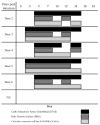EHDV-2 Infection Prevalence Varies in Culicoides sonorensis after Feeding on Infected White-Tailed Deer over the Course of Viremia
- PMID: 31018507
- PMCID: PMC6521023
- DOI: 10.3390/v11040371
EHDV-2 Infection Prevalence Varies in Culicoides sonorensis after Feeding on Infected White-Tailed Deer over the Course of Viremia
Abstract
Epizootic hemorrhagic disease viruses (EHDVs) are arboviral pathogens of white-tailed deer and other wild and domestic ruminants in North America. Transmitted by various species of Culicoides, EHDVs circulate wherever competent vectors and susceptible ruminant host populations co-exist. The impact of variation in the level and duration of EHDV viremia in white-tailed deer (Odocoileus virginianus) on Culicoides infection prevalence is not well characterized. Here we examined how infection prevalence in a confirmed North American vector of EHDV-2 (Culicoides sonorensis) varies in response to fluctuations in deer viremia. To accomplish this, five white-tailed deer were experimentally infected with EHDV-2 and colonized C. sonorensis were allowed to feed on deer at 3, 5, 7, 10, 12, 14, 18, and 24 days post infection (dpi). Viremia profiles in deer were determined by virus isolation and titration at the same time points. Blood-fed Culicoides were assayed for virus after a 10-day incubation (27 °C) period. We found that increases in deer EHDV blood titers significantly increased both the likelihood that midges would successfully acquire EHDV and the proportion of midges that reached the titer threshold for transmission competence. Unexpectedly, we identified four infected midge samples (three individuals and one pool) after feeding on one deer 18 and 24 dpi, when viremia was no longer detectable by virus isolation. The ability of ruminants with low-titer viremia to serve as a source of EHDV for blood-feeding Culicoides should be explored further to better understand its potential epidemiological significance.
Keywords: Culicoides sonorensis; Odocoileus virginianus; epizootic hemorrhagic disease virus; hemorrhagic disease; orbivirus; white-tailed deer.
Conflict of interest statement
The authors declare no conflict of interest.
Figures





Similar articles
-
Vector competence of Culicoides sonorensis (Diptera: Ceratopogonidae) to epizootic hemorrhagic disease virus serotype 7.Parasit Vectors. 2012 Oct 17;5:236. doi: 10.1186/1756-3305-5-236. Parasit Vectors. 2012. PMID: 23075098 Free PMC article.
-
Host and Potential Vector Susceptibility to an Emerging Orbivirus in the United States: Epizootic Hemorrhagic Disease Virus Serotype 6.Vet Pathol. 2016 May;53(3):574-84. doi: 10.1177/0300985815610387. Epub 2015 Oct 12. Vet Pathol. 2016. PMID: 26459518
-
Field data implicating Culicoides stellifer and Culicoides venustus (Diptera: Ceratopogonidae) as vectors of epizootic hemorrhagic disease virus.Parasit Vectors. 2019 May 23;12(1):258. doi: 10.1186/s13071-019-3514-8. Parasit Vectors. 2019. PMID: 31122295 Free PMC article.
-
Perspectives on the Changing Landscape of Epizootic Hemorrhagic Disease Virus Control.Viruses. 2021 Nov 12;13(11):2268. doi: 10.3390/v13112268. Viruses. 2021. PMID: 34835074 Free PMC article. Review.
-
Transmission and Epidemiology of Bluetongue and Epizootic Hemorrhagic Disease in North America: Current Perspectives, Research Gaps, and Future Directions.Vector Borne Zoonotic Dis. 2015 Jun;15(6):348-63. doi: 10.1089/vbz.2014.1703. Vector Borne Zoonotic Dis. 2015. PMID: 26086556 Review.
Cited by
-
IFNAR(-/-) Mice Constitute a Suitable Animal Model for Epizootic Hemorrhagic Disease Virus Study and Vaccine Evaluation.Int J Biol Sci. 2024 May 27;20(8):3076-3093. doi: 10.7150/ijbs.95275. eCollection 2024. Int J Biol Sci. 2024. PMID: 38904031 Free PMC article.
-
The Role of Hematophagous Arthropods, Other than Mosquitoes and Ticks, in Arbovirus Transmission.Viruses. 2025 Jun 30;17(7):932. doi: 10.3390/v17070932. Viruses. 2025. PMID: 40733550 Free PMC article. Review.
-
Vector Competence of Florida Culicoides insignis (Diptera: Ceratopogonidae) for Epizootic Hemorrhagic Disease Virus Serotype-2.Viruses. 2021 Mar 5;13(3):410. doi: 10.3390/v13030410. Viruses. 2021. PMID: 33807536 Free PMC article.
-
The Global Burden of Emerging and Re-Emerging Orbiviruses in Livestock: An Emphasis on Bluetongue Virus and Epizootic Hemorrhagic Disease Virus.Viruses. 2024 Dec 26;17(1):20. doi: 10.3390/v17010020. Viruses. 2024. PMID: 39861809 Free PMC article. Review.
-
Recognition of Field Signs, Necropsy Procedures, and Evaluation of Macroscopic Lesions of Cervids Infected with Epizootic Hemorrhagic Disease Virus.Methods Mol Biol. 2024;2838:17-64. doi: 10.1007/978-1-0716-4035-7_2. Methods Mol Biol. 2024. PMID: 39126622
References
-
- Anthony S.J., Maan S., Maan N., Kgosana L., Bachanek-Bankowska K., Batten C., Darpel K.E., Sutton G., Attoui H., Mertens P.P. Genetic and phylogenetic analysis of the outer-coat proteins vp2 and vp5 of epizootic haemorrhagic disease virus (EHDV): Comparison of genetic and serological data to characterise the ehdv serogroup. Virus Res. 2009;145:200–210. doi: 10.1016/j.virusres.2009.07.012. - DOI - PubMed
-
- Allison A.B., Goekjian V.H., Potgieter A.C., Wilson W.C., Johnson D.J., Mertens P.P., Stallknecht D.E. Detection of a novel reassortant epizootic hemorrhagic disease virus (EHDV) in the USA containing RNA segments derived from both exotic (EHDV-6) and endemic (EHDV-2) serotypes. J. General Virol. 2010;91:430–439. doi: 10.1099/vir.0.015651-0. - DOI - PubMed
-
- Ruder M.G., Lysyk T.J., Stallknecht D.E., Foil L.D., Johnson D.J., Chase C.C., Dargatz D.A., Gibbs E.P. Transmission and epidemiology of bluetongue and epizootic hemorrhagic disease in north America: Current perspectives, research gaps, and future directions. Vector Borne Zoonotic Dis. (Larchmont, N.Y.) 2015;15:348–363. doi: 10.1089/vbz.2014.1703. - DOI - PubMed
Publication types
MeSH terms
LinkOut - more resources
Full Text Sources

